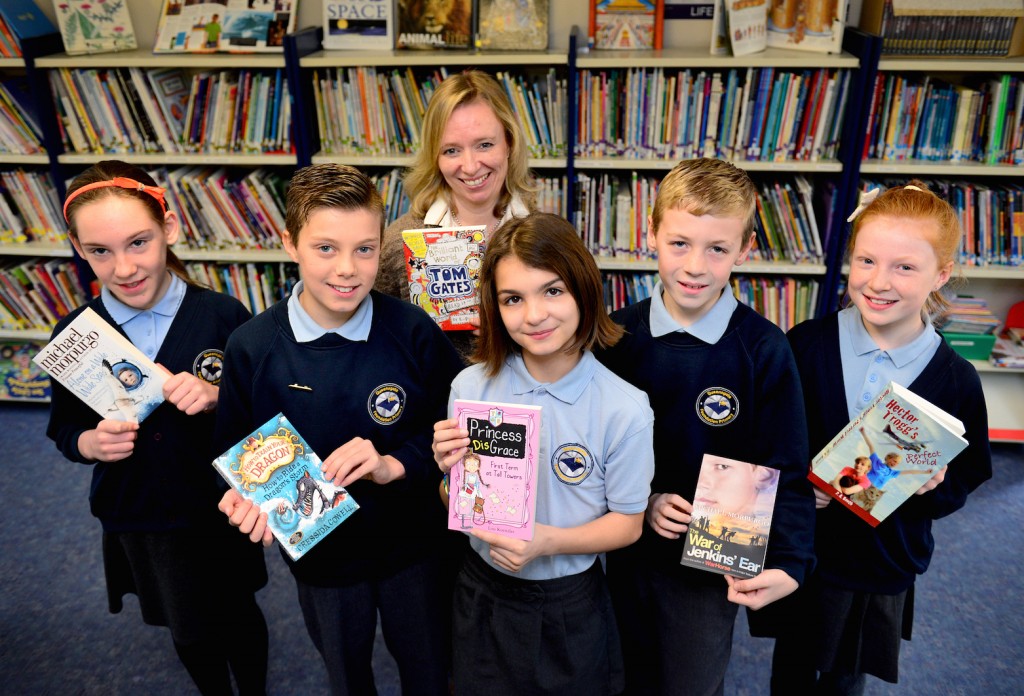Technology has dramatically changed the world we live in and it will continue to do so. Yet as we become more and more dependent on technology across all industries, the human desire to read remains.
Across all corners of the globe, from young to old, reading books has remained popular for centuries. While this continues to be the case, the way we are accessing books is ever changing.
Over the last 10 years we saw a switch towards e-books and the use of Kindles, but as we enter a new decade, has our love for the physical copy remained?
We decided to undertake some research into people’s preferred reading habits, to discover if hard copies are back in fashion.
To do so, we surveyed 1,000 adults across the UK to understand how people are reading, how that differs between the men and women, and different generations and – crucially – if our love for real books remains.
Ebooks vs hard copies
The introduction of the Kindle in November 2007 spearheaded a new way of consuming literature and challenged our traditional way of reading.
However our research revealed that a huge proportion of the UK population has resisted ebooks.
Out of the 1,000 surveyed 43 per cent admitted that they don’t own a kindle.
30 per cent were proud e-book converts, who said they only ever read on digital devices.
However the remaining 27 per cent, one in four of all adults surveyed, admitted they own a Kindle AND still buy paperbacks and hardbacks.
Which means that while over half Brits own a Kindle, nearly three in four Brits still buy physical books.
Preferred way to read
Does this mean that Kindles are gathering dust?
To understand, we asked participants to state their preferred methods of reading.
Physical books triumphed in popularity, with more than half (53 percent) stating its their preferred way to enjoy a novel or piece of non-fiction.
Digital consumption was second. However, only 25 percent say they prefer to use either a kindle (16 percent), a mobile app (5 percent) or an iPad (8 percent).
Interestingly audio books was the preferred option for just 4.6 per cent – one in twenty of us.
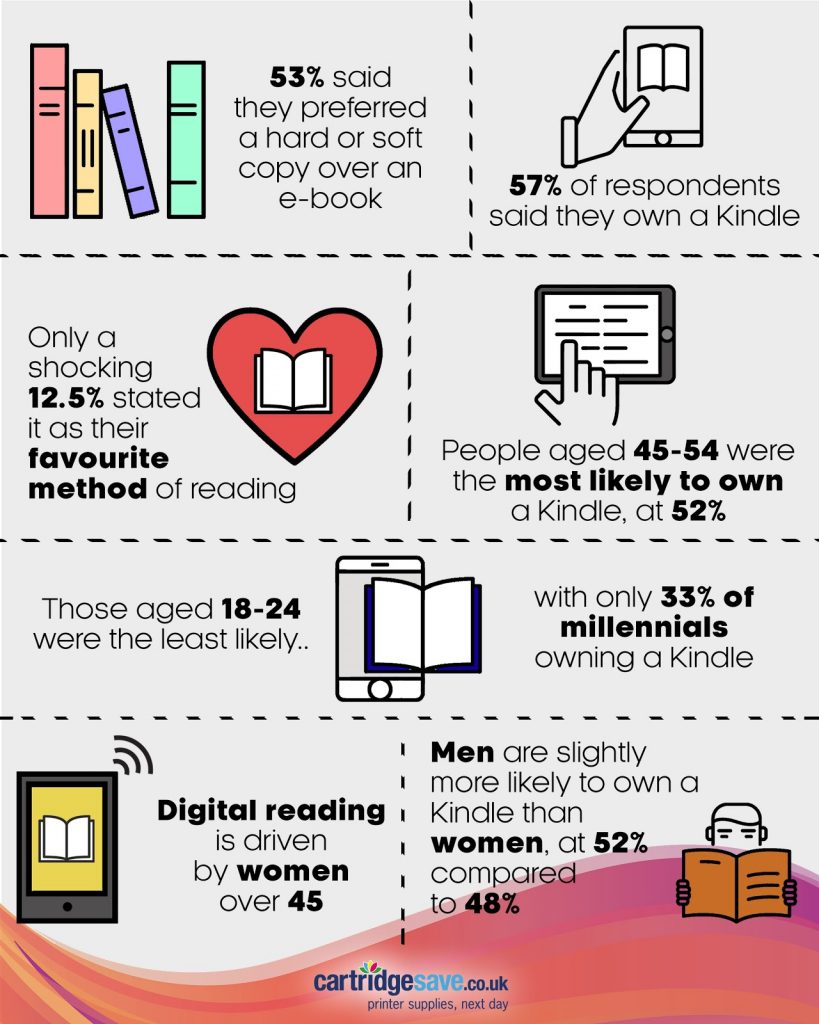
Age Demographics – who prefers a physical copy?
Generally, we saw similar results in terms of Kindle owners across the age groups. Respondents aged 45-54 were the most likely to own a Kindle, at 52 per cent, while – interestingly – those aged 18-24 were the least likely (33 per cent).
However, delving deeper into our research, we discovered some interesting differences amongst age groups and their loyalty to the Kindle. For respondents who own a Kindle, those aged 45-54 were the most likely to still purchase physical books (33 per cent). However, only 15 per cent of Kindle owners aged 18-24 continued to purchase physical books. This suggests that the printed word is falling out of fashion with the under 25s and is being replaced by either audio books or a disinterest in fiction and non-fiction as a whole.
Difference between genders?
Falling in line with gender stereotypes, gadget-happy guys are more likely to own a Kindle than women. 52 per cent of men own a Kindle compared to 48 per cent of women.
Out of those who own a Kindle, men are less likely to continue to purchase physical books. 57 per cent of men who own a Kindle no longer buy physical books. However, more than half of women (54 per cent) continue to purchase physical books after buying a Kindle.
Interestingly, more women in our survey prefer a physical book over a Kindle, with 56 per cent voting for hard copy as their preferred way of reading. Only 43 per cent of male respondents selected this answer.
In contrast male respondents were more likely opt for a digital way to read. 60 percent of those who opted for ‘iPad’ as their preferred way to read were men, compared to 40 per cent of women. Male respondents were also more likely to select “Kindle” as their preferred method of reading compared to women, suggesting that men in the UK are more digitally committed than women.
Drop in the popularity of ebooks
As part of our research, we analysed search volumes for Kindles across the last 15 years to understand if sales of ebooks are falling.
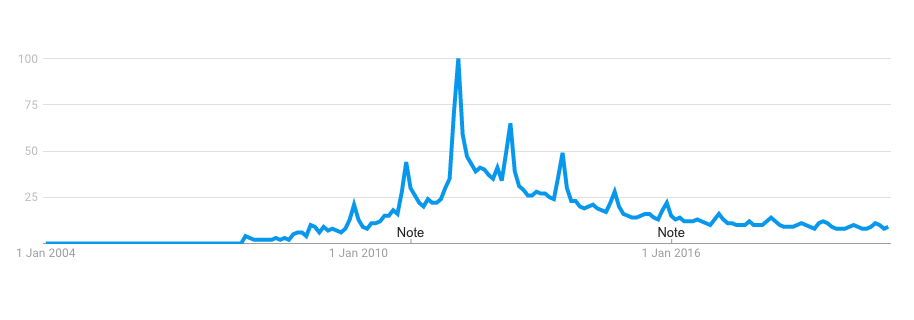
We can see a sharp rise in Google searches for Kindle from 2007 through to 2011, with December 2011 peaking in popularity, indicating its popularity as a Christmas gift.
However, after 2011 we see a steady decline in Google searches for Kindle. This decline suggests a waning interest in ebooks and complements a 2013 survey by Voxburner. Their research found that ebooks were losing popularity as young readers “enjoy holding the product”, citing this demographic’s desire to establish a physical and emotional through holding a book.
Against this landscape it’s interesting to note that searches for bookshops have held steady for the last 10 years. Between 2004-08 the number of people searching for local book shops dropped significantly. However since then, the number of searches have maintained year on year.
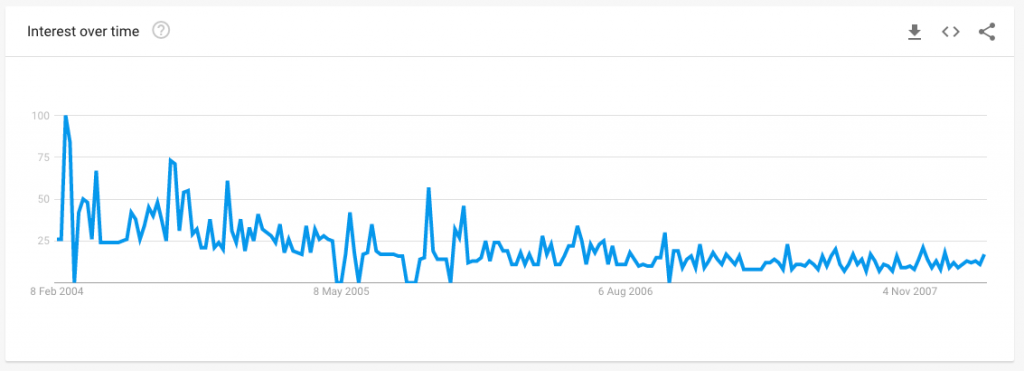
The rise of the independent book shop
With the release of the Kindle and other ebooks, independent book shops have faced an uncertain future in the UK.
However, research by the Booksellers Association reveals a resurgence in independent bookshops. Data collected by their annual membership survey claimed that independent books shops are not only surviving, but growing in numbers. From 2018 to 2019, 15 new independent book shops opened in the UK, growing for the second year in a row.
Why we love real books
Whilst readers have been swayed to switch to digital reading, the advantages of hard copy are still prevalent. Educationally, students are more likely to absorb information when looking at printed books rather than a screen. Research, by the Evolution of Reading in the Age of Digitisation, based at the University of Limerick, of over 170,000 students across Europe found that students are more likely to absorb information on printed screens rather than on a digital device.
Furthermore, being able to physically hold a book is something that the Kindle is struggling to compete with. Catherine Summerhayes of literary agency Curtis Brown said “I think your average reader would say that one of the great pleasures of reading is the physical turning of the page. It slows you down and makes you think.”
The British bookworm
The good news is whether reading via ebook or hard book, on a Kindle or a physical copy, Brits are continuing to read. Statistics from the Nielsen Bookscan revealed that in 2018 alone, 191 million books were sold in the UK.
In fact, in a survey conducted by You Gov, 47 per cent of Brits label themselves avid or regular readers, with a further 34 per cent describing themselves as occasional readers.
Another study by OnePoll found that Brits will read on average 600 novels in a lifetime, with The Lion, the Witch and the Wardrobe, The Da Vinci Code, and Harry Potter coming in at some of our most popular reads nationwide.
Book sales statistics
When it comes down to commercial books sales, physical book sales accounted for £2.9 billion sales in 2018, according to industry authority, the Publishers Association.
In comparison, ebook sales – while up 5 per cent, year on year – only raised £653 million in sales. While it looks like our love for physical copies is here to stay, a trend to watch is the rise of the audio book. Over the same period, book sales for audio grew a staggering 43% to £69m in sales. Looking at the recent boom in podcast popularity, it’s safe to say that Brits are turning their attention to audio related content, with one in eight Brits surveyed in the Media Nations 2019 report admitting to listening to a podcast every week.
SPECIFICATIONS
Reading is a basic key skill that when nurtured and encouraged forms the very heart of a child’s character and childhood memories.
However, the rise in screen time, the closure of libraries and changing family dynamics has changed our reading habits. To understand the impact this is having on our children we’ve undertaken some extensive research to discover when they’re reading, what they’re reading, and the social, economic and health impact of these changes. In the process we’ve uncovered some interesting trends and children’s book statistics.
We based our survey on a 2000-strong study group of parents from across Great Britain. Hailing from diverse backgrounds, in order to have a clear picture of the reading facts and figures of primary school-age children.
THE RETURN OF THE CHILDREN’S CLASSIC
Interestingly, our research revealed the nation’s favourite children’s books are those written long before today’s generation’s grandparents were born.
Forget Harry Potter, Hunger Games or The Gruffalo – the best children’s books are classics from the 1940s and beyond.
In our deep dive into children’s books, our statistics revealed Enid Blyton’s classic Famous Five series is the nation’s top choice – the first of which was published in 1942.
CS Lewis’ The Lion, The Witch And The Wardrobe was the second most popular – despite being written in 1950. While third was the even older Secret Garden by Frances Hodgson Burnett, which dates back over 100 years to 1911.
Collectively Roald Dahl is still the most popular children’s author with Matilda, Charlie and the Chocolate Factory, James and the Giant Peach and Fantastic Mr Fox standing? the test of time. As a result Roald Dahl made it onto the top 10 list three times with The BFG (1982) at number four, Matilda at number seven and Charlie And The Chocolate Factory (1964) at number eight.
Google trends’ data supports this theme – with Roald Dahl still being the most searched for children’s author in the last 12 months – beating JK Rowling, Jacquline Wilson, Julia Donaldson, and Enid Blyton.
The top ten most popular children’s books were recorded as follows:
- Enid Blyton’s classic Famous Five
- CS Lewis’ The Lion, The Witch And The Wardrobe
- Secret Garden by Frances Hodgson Burnett,
- The BFG (1982) Roald Dahl
- The Faraway Tree (1943)
- The Hobbit (1937)
- Matilda (1988)
- Charlie And The Chocolate Factory (1964)
- The very Hungry Caterpillar
- Charlotte’s Web (1952)

THE DEMISE OF FAIRY TALES
However, while children’s authors have stood the test of time, fairy tales written more than two centuries ago are deemed irrelevant by most.
Our report revealed that one in ten parents don’t bother with outdated fairytales at all – however of those that do a third admit to making the tales more relevant to modern life by replacing characters with more modern day alternatives.
Prince Harry was a common replacement (13 per cent) followed by Ed Sheeran (10 per cent), David Walliams (7 per cent), Holly Willoughby (6 per cent), Mo Farah (5 per cent), and Harry Kane (4 per cent).
The moral of a story may be timeless, but the fairytale considered the most outdated by parents are Sleeping Beauty (17 per cent), Rumpelstiltskin (15 per cent), Hansel And Gretel (14 per cent), Cinderella (13 per cent), Snow White (13 per cent), and The Princess and The Pea (11 per cent).
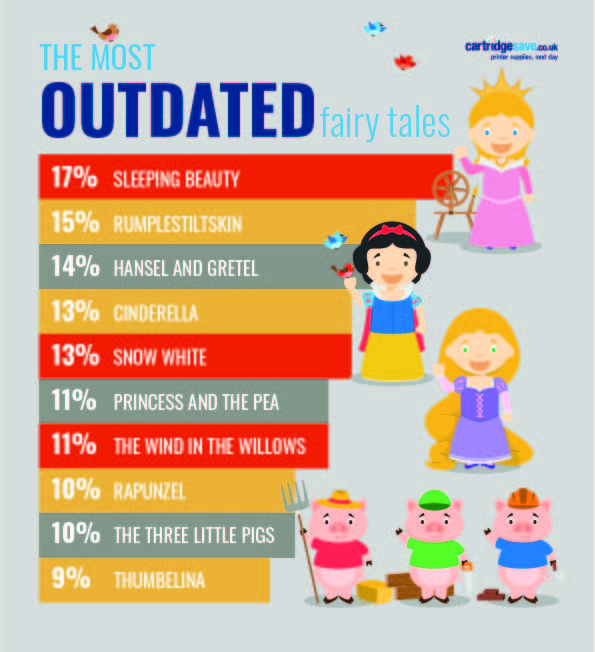
Delving into the research further, parents feel that parts of these stories need changing as a quarter are worried about what their children might think of the real endings (26 per cent).
Over a third (36 per cent) feel that the morals are wrong and that they don’t represent modern day life anymore.
The themes that mums and dads feel are in need of inclusion in modern-day moral stories
for their children include: the importance of being independent (30 per cent), not being pressured to look a certain way (27 per cent), not seeking to live ‘happily ever after’ (25 per cent), multiculturalism (21 per cent), feminism (18 per cent) and the impact of social media on today’s society (13 per cent).
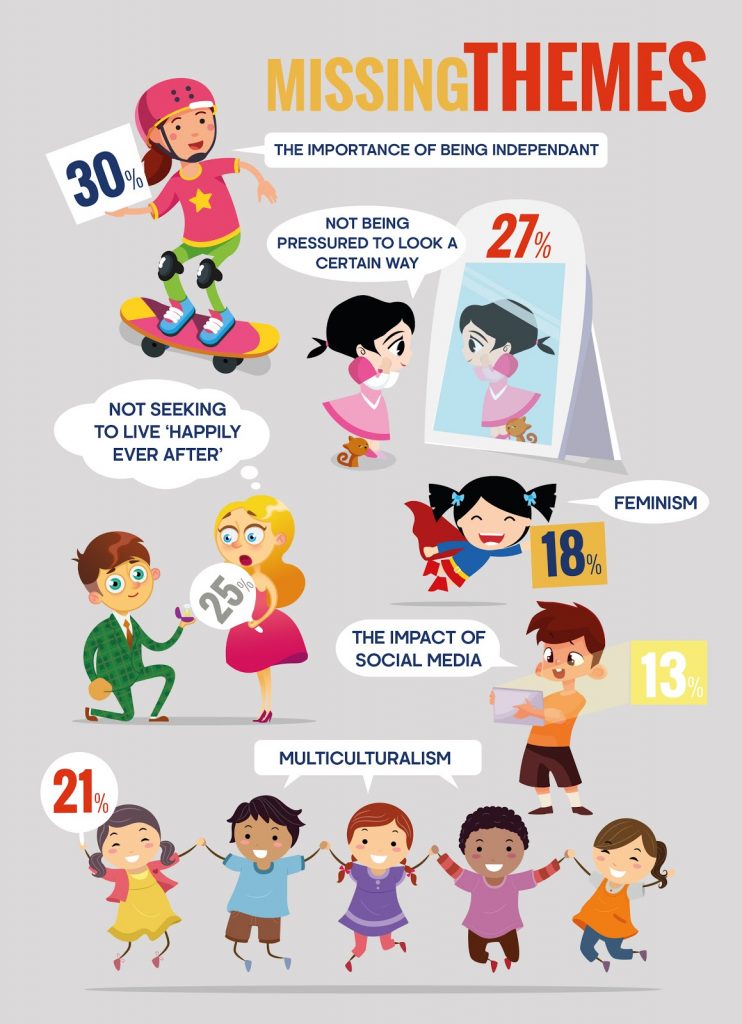
RISE IN SALES
Last year overall book sales revenue in the United Kingdom was recorded as down during 2018, according to Statista, an industry authority.
However, in the face of this decline, sales for children’s books and non-fiction were up.
Publisher sales for take home physical children’s books was recorded to have reached £242million in 2018 – with 191 million books sold in the UK. This was up from £239 million in 2017.
Sales of hard copy books saw a dramatic decline between 2009 and 2014 – with adult fiction declining by £150million. The cause of the hit to the market was placed at the rise of e-books, with more and more Brits migrating towards Kindles as their preferred method of reading.
However, even then, sales of children’s books continued to rise with parents, teachers and children casting technology aside, reaching for hard colourful copies to engage imagination instead.
Despite warnings of increased screen time, cuts to library services and a lack of books in schools meant in 2018 one in three books bought were kid-lit.
BOOK POVERTY
Children are reading less than ever before. Research in 2019 by the National Literacy Trust shows that in 2019 just 26% of under-18s spent some time reading. This is the lowest level since the charity first surveyed reading habits in 2005.
This figure is stark, against a context of growing book poverty. In November 2018 the National Literacy Trust revealed 383,775 children in the UK don’t own a single book of their own. Yet when children who do own a book are six times more likely to read above the level expected of their age.
Against this decline, Labour research in 2019 showed that the number of books borrowed from libraries in England has dropped from 255,128,957 in 2011 to 157,387,109 in 2018 – a 38% decrease.
This decline comes against a backdrop of library closures, with more than 700 closed since 2010 according to Library Campaign.
SOCIO-ECONOMIC AND HEALTH BENEFITS OF READING
The reading statistics we collated also suggests that learning how to read the printed word has a major impact on developing other abilities, which are pivotal to success in later life – with 83 per cent saying it had a positive impact on communication and writing skills.
The data also revealed three quarters of those surveyed (74 per cent) believe reading is the most important life skill a child can learn.
This supports research in 2013 by The Organisation for Economic Co-operation and Development (OECD), that shows that in England the median hourly wage of workers with the highest levels of literacy is 94 per cent higher than for workers who have the lowest levels of literacy. The same report revealed that literacy has been found to have a relationship with depression. 36 per cent of those with low literacy were found to have depressive symptoms, compared to 20 per cent of those with the highest levels of literacy.
A similar report in 2013 by Sullivan and Brown (2013) states in their Social inequalities in cognitive scores at age 16: The role of reading concluded that reading for pleasure is more important for children’s cognitive development than their parents’ level of education and is a more powerful factor in life achievement than socio-economic background.
In their follow up analysis in 2014 they deduced that low levels of literacy cost the UK an estimated £81 billion a year in lost earnings and increased welfare spending impacted on the economy as a whole.
SPECIFICATIONS
Heading to university soon?
Moving to a new city is a giant step, there is a lot to organise, but we are on hand to help out!
From your bedroom to bathroom, lectures and beyond… Here’s our printable university checklist and make sure you’ve packed all the essentials!
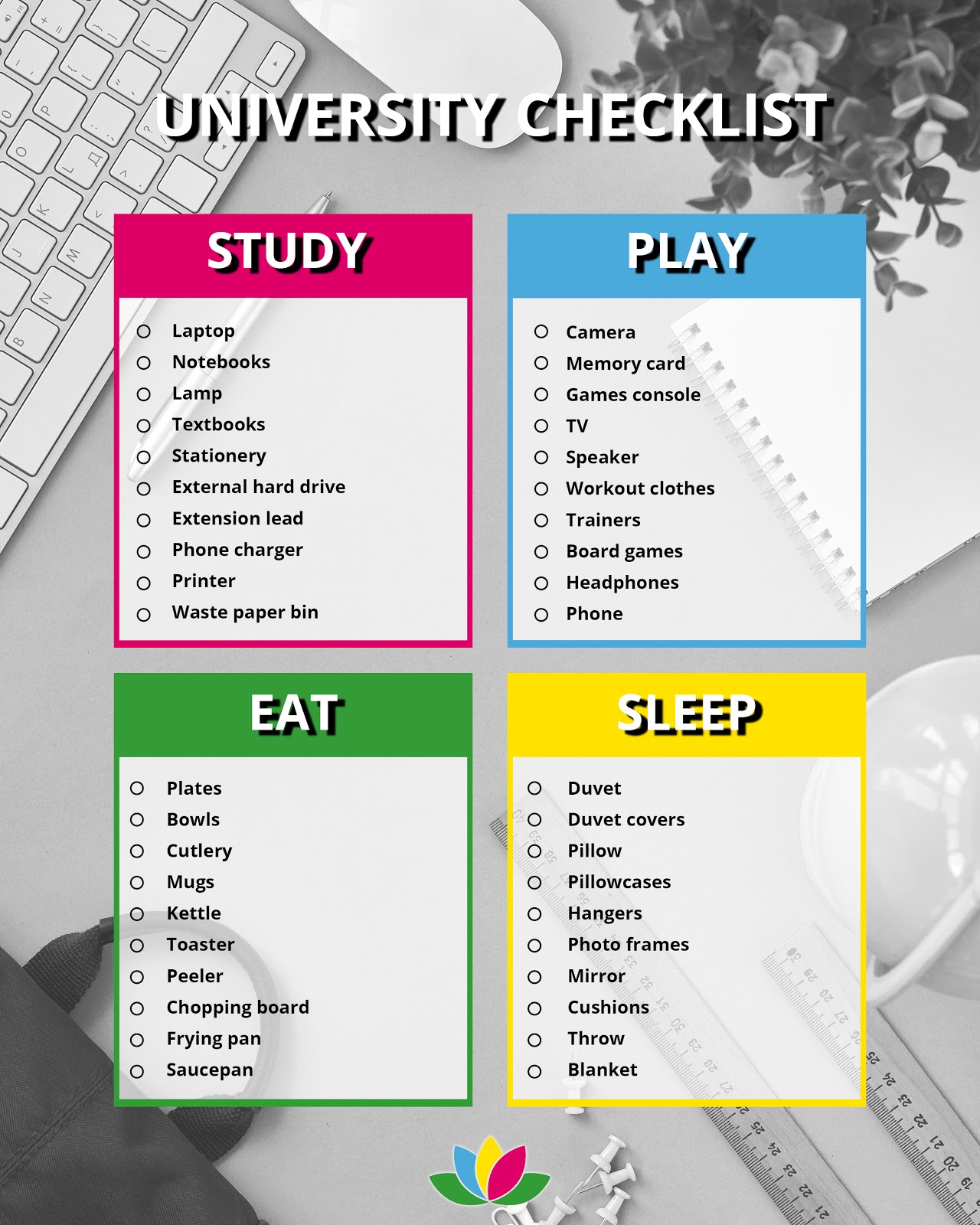
SPECIFICATIONS
Heading to university this September? We want to make your life easier! Here are a few simple ways to save yourself some money when starting the semester.

1- Have At Least One ‘No-Spend’ Day Each Week
Dedicate at least one day a week where you will spend £0. Take your leftovers to uni, walk to your lectures… It really is so simple!
2- Join Your University Gym
Say goodbye to £80 a month gym’s, sure you may have to give up a little luxury and there may not be a sauna, but think of all the £££ you’ll be saving.
3- Goodbye taxis…. Hello buses!
Public transport will become your new best friend when looking to save money at university. Get the bus instead of a taxi and watch the savings pile up, look into getting a bus pass for even more savings!
4- Squeeze The Most Out Of Your Toiletries
Squeezed all you can out of your toiletries? Cut the top off your toothpaste, shower-gel or moisturiser and get even more out!
5- Don’t Pay To Withdraw Your Own Cash
Avoid pesky cash machines that charge you to withdraw cash, instead look for free cash machines and withdraw from those instead – a simple yet effective saving solution.
6- Leftovers For Lunch
Don’t throw away the remains of your dinner, instead take it for your lunch the following day. We all know how great leftovers taste anyway… it’s a no brainer!
7- Ask For Discounts
You’re a student… Make the most of it! Lot’s of cafe’s, restaurants, bars and shops offer students discounts. If you don’t ask, you don’t get so it’s definitely worth checking.
8- Buy or Rent Textbooks
Textbooks can be expensive and you may only use them for one term. Reach out to older students and join course Facebook groups as lots of students tend to rent or sell their unwanted textbooks, meaning YOU save some money.
9- Limit Eating Out
Eating out is expensive, try saving your restaurant trips for special occasions and cook for your new housemates!
10- Leave Your Bank Card At Home On Nights Out
A tip guaranteed to save you some pennies, leave your bank card at home and budget yourself to a set amount of cash to take out with you.
SPECIFICATIONS
Children from across the UK can make their school’s Christmas wishes come true – by taking part in a national writing competition.
Sam Hay, author of the Undead Pets series, and cartridgesave.co.uk are inviting children aged between four and eleven to write a short story (maximum 200 words) or poem inspired by winter or Christmas, for a chance to win £1,500 for their school.
The Write Christmas competition, back for its third consecutive year, will select the top 50 entries from across the UK to be published in a special free to download e-book, to be released in December 2016.
In addition, one overall winner will receive a £1,500 grant for their school to spend on books or writing equipment. Two runners up will each secure a £250 each for their schools.
Both the overall winner and the runners up will also get a stocking packed full of festive treats worth £50 for themselves.
The stories or poems will be judged by Sam Hay and a representative from cartridgesave.co.uk.
Children, parents and teachers can get hints and tips from Sam Hay, plus full details of how to enter at www.cartridgesave.co.uk/printwhatmatters/write-christmas.
Sam Hay believes the competition is a great step towards unlocking children’s creativity. She says: “I’m thrilled to be judging the fantastic Write Christmas story competition again. It’s an excellent opportunity for kids to unleash their imaginations and get writing!
“Christmas has long been an inspirational time for stories; from the Dickens’s classic A Christmas Carol to the much-loved Nutcracker. Christmas is a magical time, full of wonder and excitement. I can’t wait to read this year’s entries!”
Ian Cowley, Managing Director of cartridgesave.co.uk, comments: “The power of children’s imagination is incredible. We want to help cherish their amazing creativity through this challenge. It celebrates their writing ability; creates a lasting testimony through the printable e-book; and nurtures their talent further by providing essential funds to get more printed word into schools.”
Last year’s Write Christmas winner was Anouk Wood, aged 7, who captured the judges’ imagination with her “highly original, funny and well written” story about the secret to making a magic Santa suit.
You can read her winning story Urgent! Make Santa a New Suit, Deadline 24thDecember here: www.cartridgesave.co.uk/printwhatmatters/write-christmas
Useful information:
-
The competition has three categories: 4 – 6, 7 – 9 and 10 – 11 years old
-
There will be one overall winner across all categories. The winning school will receive £1,500 to spend on books or writing materials and the winning child will receive a goody bag worth £50.
-
Two runners up will win £250 for their school to spend on books or writing materials, as well as a £50 goody bag each.
-
The best 50 entries from across all categories will be selected to appear in the e-book.
-
Poems and short stories (200 words or less) must be entered by a caregiver, parent or teacher, who can give permission for the story, name and age of the child to be included in the book.
-
The judges’ decision is final and no correspondence will be entered into.
Closing date for entries is 5th December 2016.
SPECIFICATIONS
Pupils at Queensgate Foundation Primary School in East Cowes are looking forward to starting an exciting new chapter after receiving a donation of brand new books.
The delivery of reading books, worth £500, came from cartridgesave.co.uk as part of the retailer’s nationwide campaign to get the printed word into schools around the country
Delighted Headteacher of Queensgate Foundation Primary School, Samantha Sillito, says: “No child should miss out on the life-changing benefits of reading for pleasure. This wonderful donation of reading resources will go a long way to transforming the lives of our young students.”
Ian Cowley, Managing Director of cartridgesave.co.uk, adds: “Every book is a doorway to a world of possibilities and a simple step like making more books available to more children and parents has massive impact.
“We know that access to the right reading materials improves literacy skills, encourages more than 95 per cent of parents to read with their children and fosters a lifelong enjoyment of reading.
“We are delighted to help Queensgate Primary bring the joy of the printed word to their talented students.”
Cartridgesave.co.uk is an online retailer of ink cartridges that believes passionately in the power of the printed word. It knows that as a result of book donations: more parents are able to read at home with their children; children have the resources to read for pleasure; their literary skills improve; and local libraries see an uplift in families using their service.
Cartridgesave.co.uk is running a Print What Matters campaign throughout 2016 which will see it donate a £500 reading grant to a UK primary school each month. For more information and to request a grant visit: www.cartridgesave.co.uk/printwhatmatters.
SPECIFICATIONS








